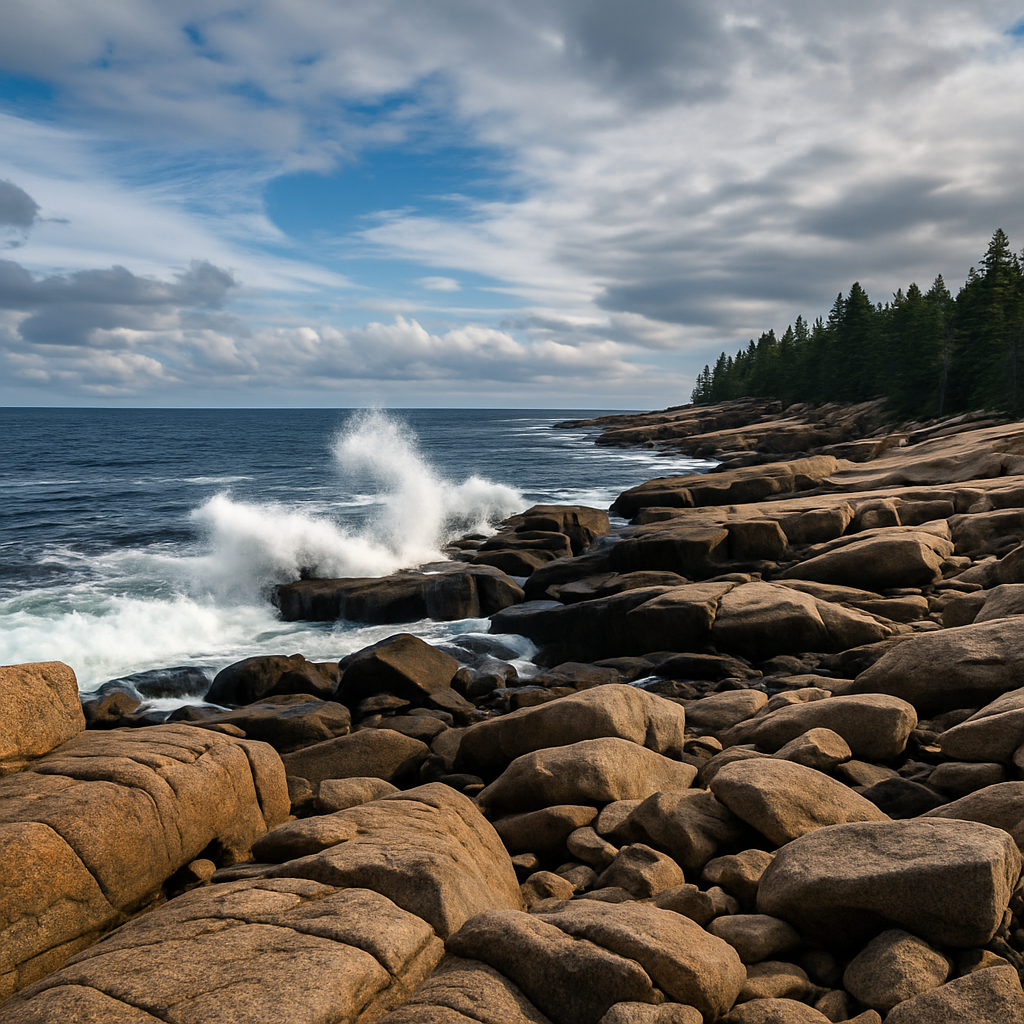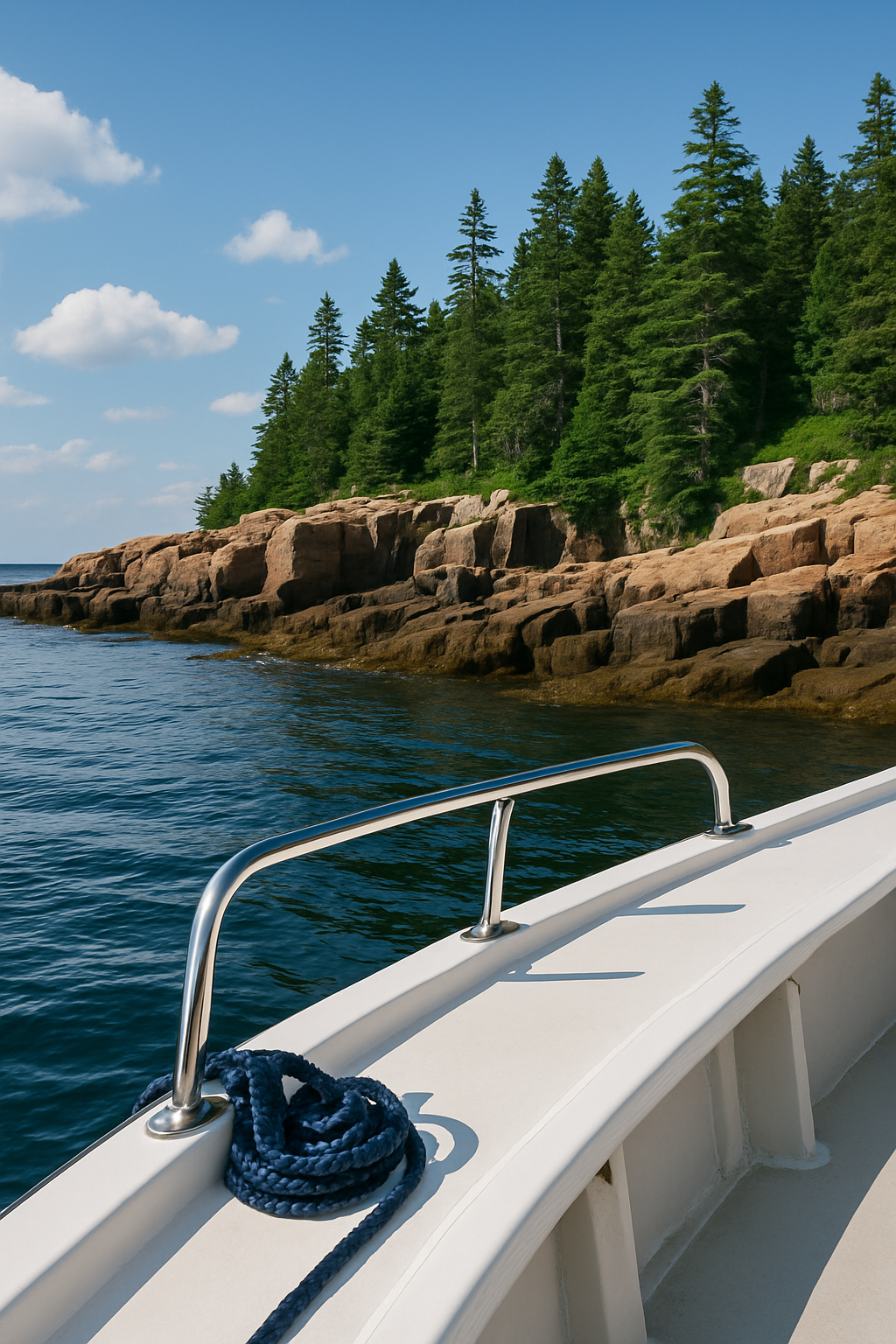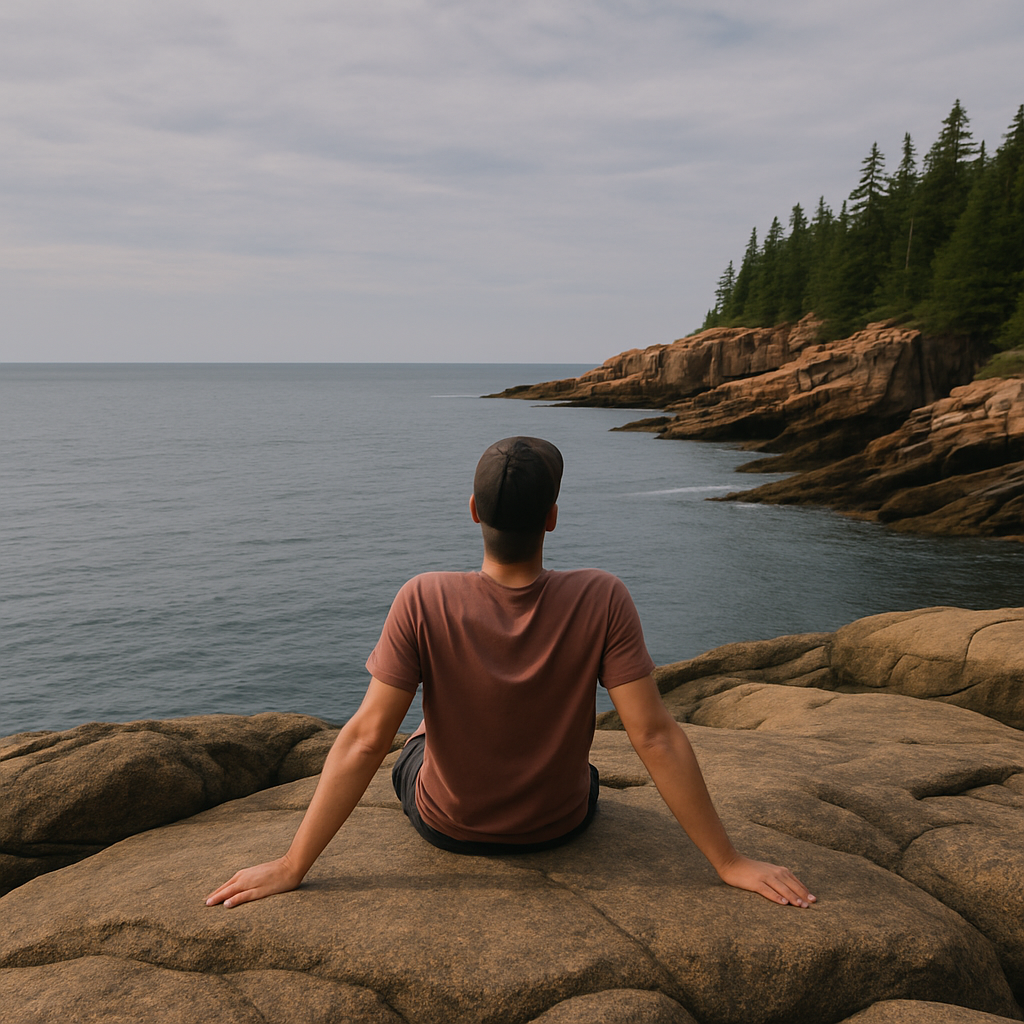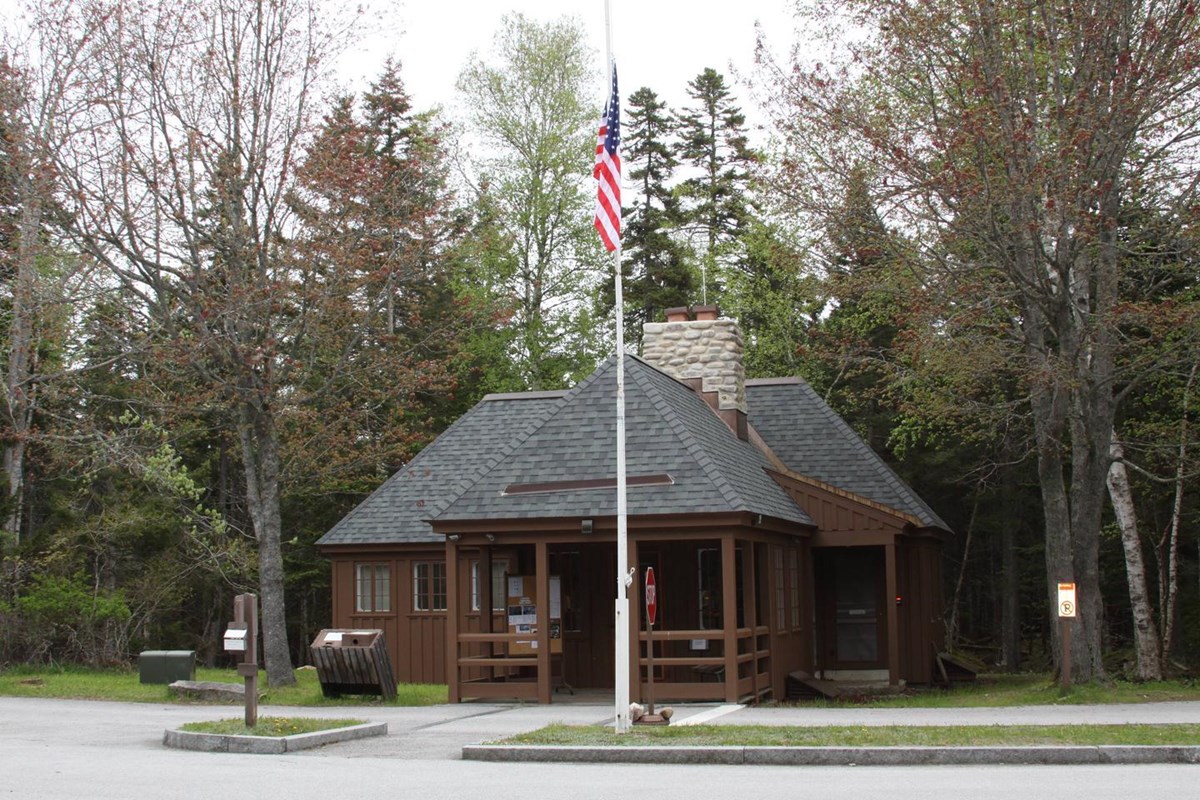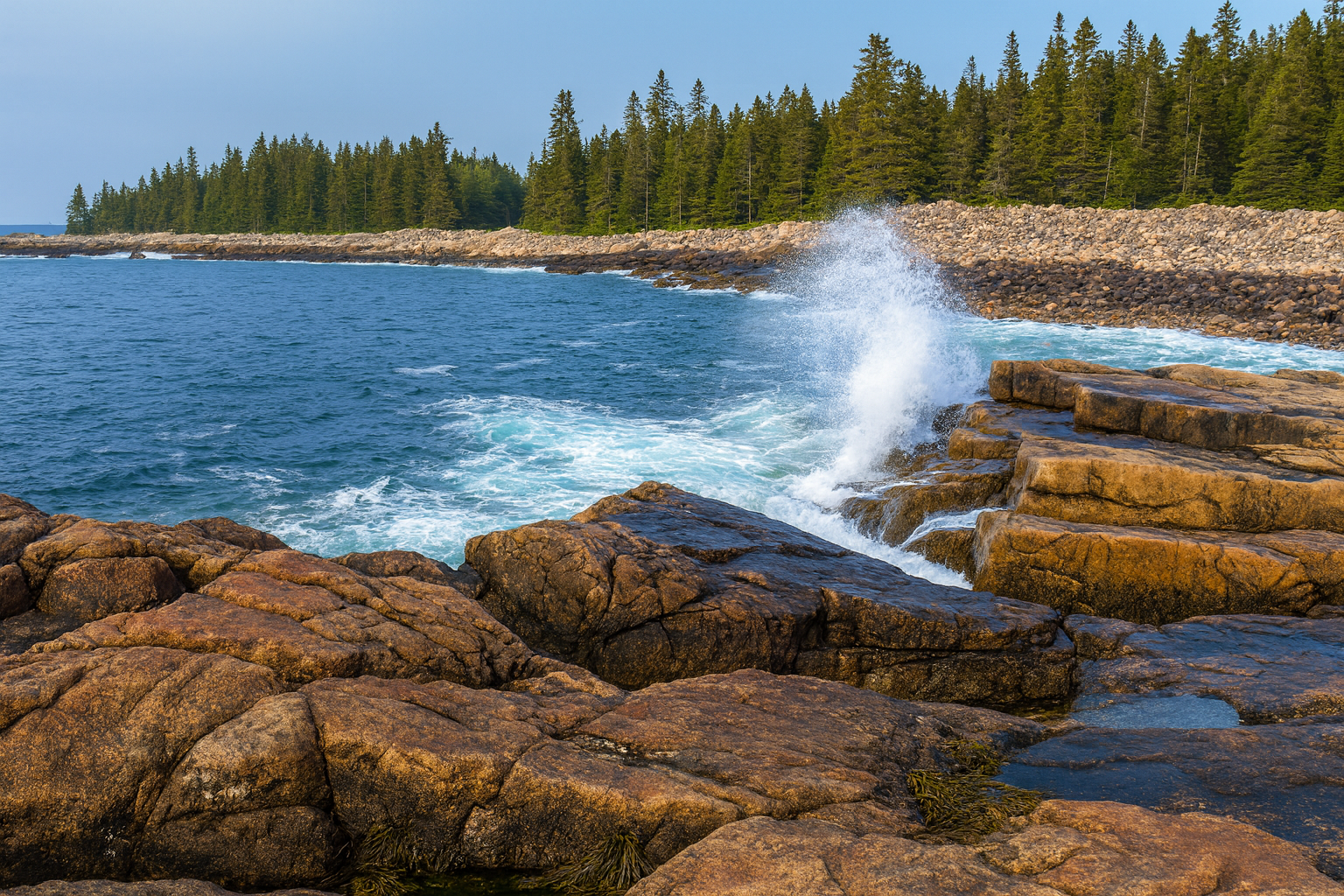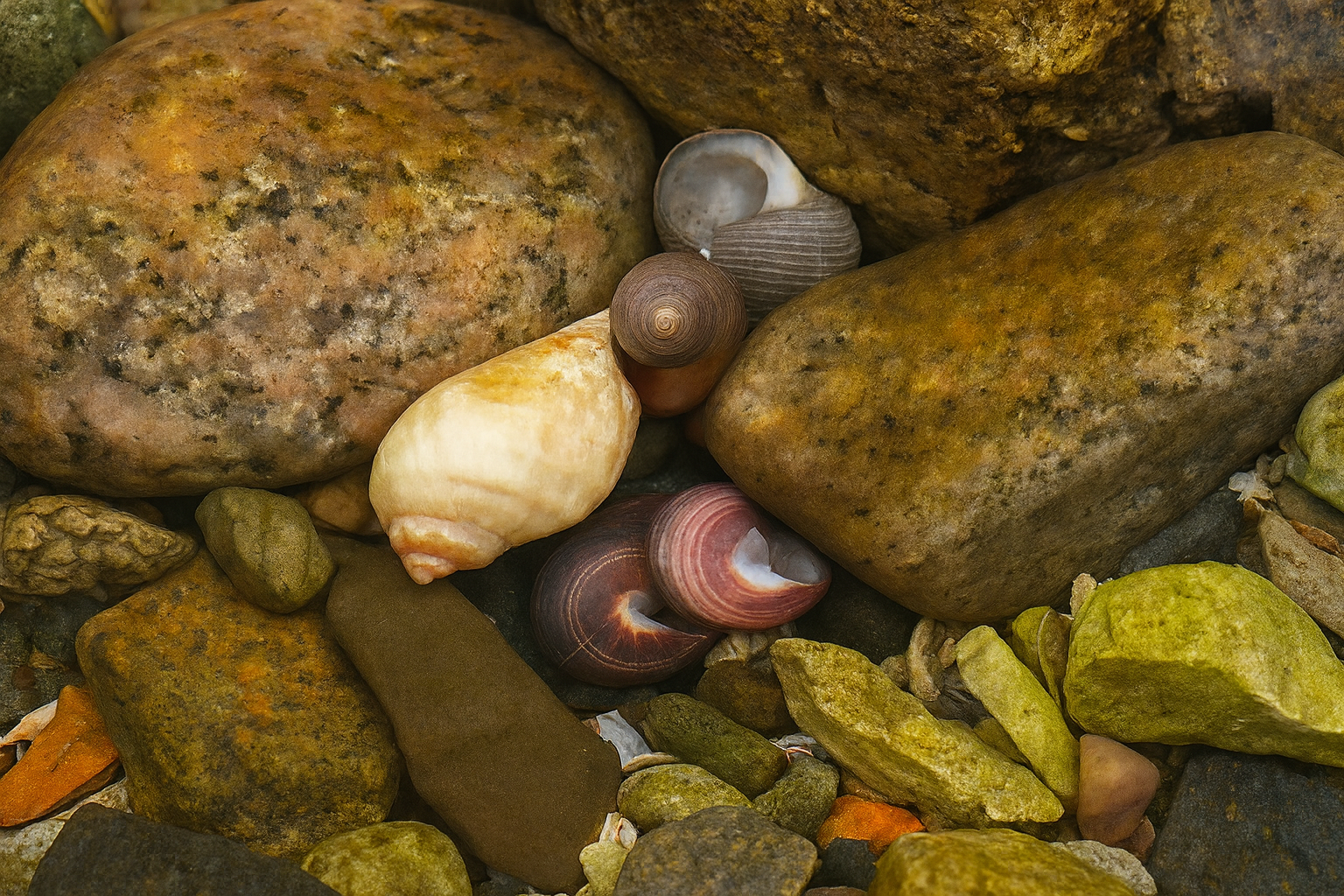Seawall Acadia National Park
On the quieter western side of Mount Desert Island, far from the bustle of Bar Harbor, lies one of Acadia’s most distinctive and dramatic stretches of shoreline: Seawall Acadia National Park. This is not a beach where you’ll spread out a towel or wade into gentle waves. Unlike Sand Beach, with its postcard-perfect crescent of sand, or Echo Lake, where families swim in calm freshwater, Seawall offers something entirely different. Here, the Atlantic pounds relentlessly against a mile-long wall of naturally piled granite boulders, a barrier created by the ocean itself over thousands of years.
Visitors who come to Seawall often remark on its rugged beauty. At low tide, the rocks stretch out toward the sea, revealing tidepools filled with crabs, snails, mussels, and barnacles — a miniature world of coastal life waiting to be discovered. At high tide, the mood shifts completely as powerful waves slam into the seawall, spraying saltwater into the air and sending a deep, rolling echo across the shoreline. It’s a place where the ocean feels alive, dramatic, and unfiltered.
Seawall also embodies the quieter side of Acadia. It’s less crowded than the park’s eastern highlights, offering a chance to slow down, listen to the surf, and enjoy a section of coast that feels both wild and timeless. With its rocky vistas, tidepooling opportunities, and a campground just across the road, Seawall is one of those places that shows visitors another dimension of Acadia National Park — raw, rugged, and unforgettable.
What Is Seawall Acadia National Park?
Seawall Acadia National Park is exactly what its name suggests: a long, rugged wall of boulders and granite ledges that stands as a natural barrier between the inner shoreline and the open Atlantic. Unlike a man-made breakwater, this formation was shaped entirely by the forces of nature. Over thousands of years, storms, tides, and relentless waves rolled stone after stone into place, building a massive defense of rock along the edge of Mount Desert Island. The result is one of Acadia’s most dramatic coastlines, a place where the power of the ocean is on full display.
Walking along Seawall Acadia National Park, visitors are struck by the scale of it — the wall stretches for more than a mile, curving with the coast. Each stone is rounded, smoothed, or cracked in its own way, evidence of the ocean’s constant shaping. At low tide, the seawall transforms into an outdoor classroom of marine life. Tidepools collect in the crevices, filled with barnacles, mussels, snails, and crabs scuttling between seaweed-covered rocks. Children crouch down to watch the miniature ecosystems, while photographers zoom in to capture close-ups of shells, colors, and textures.
When the tide turns, the atmosphere changes completely. The sea surges higher, and the once-quiet pools are swallowed by waves. Crashing surf slams directly into the wall, spraying saltwater high into the air and sending a low, booming rumble down the shoreline. It’s a sensory experience — the smell of salt, the roar of water, and the feeling of spray carried on the wind. Standing here during high tide or a storm, you get a true sense of Acadia’s raw, untamed character.
Why Visit Seawall?
- Rugged Scenery:: Seawall Acadia National Parkoffers a stark contrast to Acadia’s more polished landscapes. Instead of sandy shoreline or still waters, here you’ll find a jagged wall of granite stretching into the sea. The rocks are wave-worn and weathered, creating a raw, elemental landscape that showcases the Atlantic in its most powerful form. Standing here, you feel the strength of the ocean and the timelessness of the coast.
- Tidepooling: At low tide, Seawall Acadia National Park becomes a natural playground for discovery. Small tidepools fill the gaps between the rocks, each one a tiny ecosystem. Barnacles cling tightly to stone, mussels cluster in groups, and small crabs scuttle quickly from one pool to the next. Children and adults alike are drawn to these miniature worlds, making tidepooling one of Seawall’s most rewarding and family-friendly activities.
- Photography: For photographers, Seawall is a dream. The jagged rocks provide strong foregrounds, while the horizon stretches endlessly over the Atlantic. On clear days, the blue of the ocean and sky contrasts beautifully with the dark granite. On stormy afternoons, the surf churns and sprays, creating dramatic, moody images. Whether you’re shooting close-ups of tidepool life or wide-angle views of crashing waves, Seawall delivers endless opportunities.
- Peace and Quiet: Seawall sits on the “quiet side” of Mount Desert Island, away from the crowds of Bar Harbor and the busy Park Loop Road. Visitors often find themselves with long stretches of the seawall to explore in solitude. It’s a place to listen to the waves, breathe in the salty air, and enjoy Acadia at a slower pace. If you’re looking for an escape from the park’s busiest viewpoints, Seawall offers just that.
- Camping Nearby: Across the road, Seawall Campground provides the perfect base for an overnight stay. Campsites are tucked into wooded areas, and many campers fall asleep to the sound of the ocean in the distance. Staying here means you can enjoy Seawall at sunrise or sunset, when the light is soft and the shoreline is at its most peaceful. It’s a chance to fully immerse yourself in the rhythms of Acadia’s quiet side.
🌊 Did You Know?
- Natural, not man-made: Many visitors assume the seawall was built as a breakwater. In reality, it’s a natural formation shaped by centuries of pounding surf.
- Over a mile long: The seawall stretches more than a mile along Mount Desert Island’s western shore, making it one of the longest rock barriers in Acadia.
- A tidepool treasure chest: At low tide, the seawall comes alive with barnacles, mussels, seaweed, crabs, and other small creatures in tidepools between the rocks.
- Campground connection: Just across the road is Seawall Campground, the only Acadia campground where you can fall asleep to the sound of waves nearby.
- Quiet side gem: Despite its size and beauty, Seawall is far less crowded than Sand Beach or Echo Lake, making it a favorite for solitude seekers.
Exploring the Shoreline
Visitors to Seawall Acadia National Park can wander along nearly the entire mile-long stretch of the seawall, clambering over rounded boulders and broad, flat ledges shaped by centuries of pounding surf. Each part of the shoreline feels slightly different: some areas are smoother and easy to cross, while others are jagged and uneven, making every step an exploration. The scenery shifts constantly with the tide. At low tide, large sections of rock are exposed, and tidepools form natural aquariums filled with barnacles, mussels, and darting crabs. These pockets of life offer fascinating close-up encounters with Acadia’s marine world.
When the tide rolls back in, the character of Seawall changes entirely. Waves surge higher and slam directly into the rocks, filling the air with spray and a deep, echoing thunder that can be felt underfoot as much as heard. The transformation between low and high tide makes Seawall a place worth visiting more than once in the same day, since no two moments along the wall are alike.
Because the rocks are uneven and can become slick with seawater or algae, sturdy footwear is essential. Take your time as you move across the stones, pausing often to admire the view or simply sit and watch the horizon. The steady rhythm of waves colliding with Maine’s granite coast creates a natural soundtrack — one that invites you to slow down, breathe in the salt air, and truly appreciate the raw beauty of Acadia.
Seawall Campground
Just inland from the rocky shoreline lies Seawall Campground, one of only four campgrounds within Acadia National Park. Unlike the larger and busier Blackwoods Campground near Bar Harbor, Seawall offers a more rustic and relaxed atmosphere, perfectly in keeping with the “quiet side” of Mount Desert Island. Campsites are tucked beneath spruce and fir trees, providing shade, privacy, and the gentle scent of evergreens on the air.
What makes Seawall Acadia National Park especially memorable is its proximity to the ocean. From many sites you can hear the rhythmic sound of waves at night, a natural soundtrack that replaces the noise of traffic or town life. In the early morning, it’s just a short walk across the road to the seawall itself, where you can watch the first light of sunrise illuminate the rocks and tidepools. In the evenings, campers often stroll back to the shore to see the sun set into the Atlantic, with the roar of crashing surf as a backdrop.
Seawall Campground is popular with those who want a quieter, more natural camping experience. Facilities are simpler than at Blackwoods, but the trade-off is a deeper sense of peace and connection to nature. Families appreciate the easy access to the coast, while couples and solo travelers often highlight the serenity and slower pace.
Because it is smaller and located on the west side of the island, reservations for Seawall can be easier to secure than at Blackwoods, though spots still fill quickly in July and August. Like the park’s other campgrounds, Seawall is open seasonally, typically from late spring through mid-fall. Reservations are required during peak season, and it’s always best to book well in advance.
For campers who want to truly immerse themselves in Acadia’s quieter landscapes, spending a night or two at Seawall Campground is one of the most rewarding choices you can make.
Wildlife and Scenery
Seawall Acadia National Park is also a rewarding spot for wildlife watchers. The rocky shoreline attracts a variety of shorebirds and seabirds throughout the year. Gulls are ever-present, calling overhead and wheeling in the wind, while sleek cormorants spread their wings to dry on nearby rocks. In the colder months, flocks of eider ducks can often be seen floating just offshore, their distinctive plumage standing out against the gray Atlantic. On calm days, patient visitors may even spot harbor seals hauled out on offshore ledges, resting in the sun between fishing trips.
Beyond the wildlife, Seawall offers sweeping panoramic views of the Atlantic Ocean. The scene is always changing: on clear days the horizon stretches endlessly in shades of blue, while stormy weather transforms the coastline into a display of crashing surf and dramatic skies. Many visitors describe it as one of the most raw and untamed viewpoints in Acadia, where the true power of the ocean is on full display.
In spring and summer, Seawall softens around the edges with bursts of color. Wildflowers bloom along the roadside and grassy edges, offering a gentle contrast to the black and gray granite of the seawall itself. Bright yellows, purples, and whites pop against the muted tones of the rocks and sea, creating striking photo opportunities. Combined with the evergreens that frame the shoreline, the result is a landscape that feels both rugged and quietly beautiful.
Together, the mix of wildlife, ocean views, and seasonal color makes Seawall one of the most well-rounded destinations on the quiet side of Mount Desert Island — a place where nature’s drama and its subtler details blend seamlessly.
Tips for Visiting Seawall
Location: Seawall Acadia National Park is located on the western side of Mount Desert Island, in the part of Acadia often called the “quiet side.” It’s about a 20–30 minute drive from Bar Harbor, making it an excellent destination if you want to escape the busier eastern half of the park. The drive itself is scenic, winding past small harbors, villages, and stretches of forest.
Parking: Roadside parking is available along Seawall Road, directly beside the shoreline. In summer, especially on sunny afternoons or weekends, spaces can fill quickly. Arrive earlier in the day if you want a guaranteed spot, or visit in the evening when crowds have thinned and the light is at its most beautiful. Additional parking is available across the road at the Seawall Campground, where visitors can also find picnic areas, restrooms, and access to ranger information.
Best Time to Visit: Both low tide and high tide bring unique experiences. At low tide, tidepools are exposed, offering great opportunities for families and nature lovers to explore. At high tide, the seawall becomes more dramatic as waves crash directly against the rocks, sending salt spray into the air. For the quietest visits, come in the early morning or evening.
Footwear: The rocks at Seawall can be uneven and slippery, especially when wet or covered with seaweed. Wear sturdy shoes with good grip to move safely along the stones. Avoid flip-flops or smooth-soled sandals, as they can make the rocks difficult to navigate.
Duration: Plan to spend 1–2 hours exploring the seawall itself. If you’re staying at Seawall Campground or visiting nearby towns, you may find yourself returning more than once — sunrise, sunset, or stormy days all offer completely different experiences.
Pairing Your Visit: Because Seawall sits farther from the main Park Loop Road, it’s best enjoyed as part of a day trip to the quiet side of Mount Desert Island. Combine it with a visit to Bass Harbor Head Lighthouse, a classic Acadia landmark, or the harborside village of Southwest Harbor, known for its working waterfront and fresh lobster. Together, these stops create a perfect itinerary that shows off a calmer, less-traveled part of Acadia.
🧭 Tips for Visiting Seawall
- Timing: High tide brings the most dramatic waves, while low tide reveals tidepools full of marine life.
- Footwear: Wear sturdy shoes — the granite boulders can be slippery with sea spray and seaweed.
- Parking: Small pull-offs are available along the Seawall section of the park; arrive early for space.
- Duration: Allow at least an hour to explore the shoreline and longer if combining with a picnic or short hike.
- Nearby Stops: Pair your visit with a trip to Bass Harbor Head Lighthouse or picnic at Seawall Campground.
Why Seawall Belongs on Your Itinerary
If you only have time for Acadia’s major highlights, you might be tempted to skip Seawall — but that would mean missing one of the park’s most authentic coastal experiences. This natural rock wall is unlike any other feature in the park. It isn’t polished or postcard-perfect, and that’s exactly what makes it so compelling. Seawall shows Acadia in its rawest form: powerful waves hammering stone, tidepools teeming with life, seabirds wheeling in the wind, and the ever-present rhythm of the Atlantic against Maine’s granite coast.
For those who want to step away from the crowds and see a wilder, quieter side of the park, Seawall Acadia National Park is the perfect choice. It’s a place where you can slow down, breathe in the salt air, and feel the timeless energy of the ocean. Whether you stay for half an hour or linger for a full day, Seawall leaves a lasting impression — rugged, untamed, and unforgettable.
🌊 Ready to Explore More?
If Seawall captures your attention, consider making it your overnight base. Our full guide to the Seawall Campground covers everything you need to know about staying here, from reservations to what to expect.
Or, if you’re planning to explore more of the coast, don’t miss our complete guide to Acadia National Park beaches — where we cover Sand Beach, Echo Lake, Compass Harbor, and other shoreline gems.
🌐 Explore More About Seawall
- National Park Service: Seawall Campground – official NPS details on camping facilities and reservations.
- AcadiaMagic: Seawall – photos, maps, and local tips for visiting the Seawall area.
